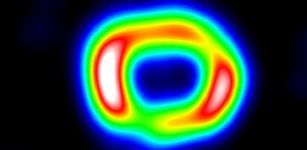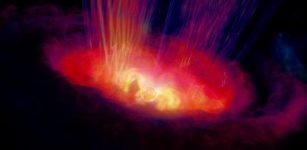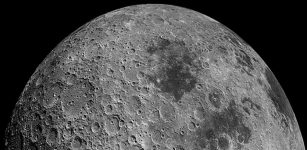Universe’s Oldest Stars In Our Own Galactic Backyard – Discovered
Eddie Gonzales Jr. – MessageToEagle.com – Three stars circling the Milky Way’s halo formed 12 to 13 billion years ago.
MIT astronomers discovered three of the oldest stars in the universe, and they live in our own galactic neighborhood. The stars are in the Milky Way’s “halo” — the cloud of stars that envelopes the main galactic disk — and they appear to have formed between 12 and 13 billion years ago, when the very first galaxies were taking shape. Credits:Image: Serge Brunier; NASA
Researchers from the Massachusetts Institute of Technology, including several undergraduate students, have made a remarkable discovery. They have identified three of the most ancient stars in the cosmos, and remarkably, these celestial bodies reside within the confines of our own galactic neighborhood.
This groundbreaking finding sheds light on the early stages of the universe’s formation and provides invaluable insights into the origin of stellar evolution.
The team spotted the stars in the Milky Way’s “halo” — the cloud of stars that envelopes the entire main galactic disk. Based on the team’s analysis, the three stars formed between 12 and 13 billion years ago, the time when the very first galaxies were taking shape.
The researchers have coined the stars “SASS,” for Small Accreted Stellar System stars, as they believe each star once belonged to its own small, primitive galaxy that was later absorbed by the larger but still growing Milky Way. Today, the three stars are all that are left of their respective galaxies. They circle the outskirts of the Milky Way, where the team suspects there may be more such ancient stellar survivors.
“These oldest stars should definitely be there, given what we know of galaxy formation,” says MIT professor of physics Anna Frebel. “They are part of our cosmic family tree. And we now have a new way to find them.”
As they uncover similar SASS stars, the researchers hope to use them as analogs of ultrafaint dwarf galaxies, which are thought to be some of the universe’s surviving first galaxies. Such galaxies are still intact today but are too distant and faint for astronomers to study in depth. As SASS stars may have once belonged to similarly primitive dwarf galaxies but are in the Milky Way and as such much closer, they could be an accessible key to understanding the evolution of ultrafaint dwarf galaxies.
“Now we can look for more analogs in the Milky Way, that are much brighter, and study their chemical evolution without having to chase these extremely faint stars,” Frebel says.
She and her colleagues have published their findings today in the Monthly Notices of the Royal Astronomical Society (MNRAS). The study’s co-authors are Mohammad Mardini, at Zarqa University, in Jordan; Hillary Andales ’23; and current MIT undergraduates Ananda Santos and Casey Fienberg.
Stellar frontier
The team’s discoveries grew out of a classroom concept. During the 2022 fall semester, Frebel launched a new course, 8.S30 (Observational Stellar Archaeology), in which students learned techniques for analyzing ancient stars and then applied those tools to stars that had never been studied before, to determine their origins.
“While most of our classes are taught from the ground up, this class immediately put us at the frontier of research in astrophysics,” Andales says.
The students worked from star data collected by Frebel over the years from the 6.5-meter Magellan-Clay telescope at the Las Campanas Observatory. She keeps hard copies of the data in a large binder in her office, which the students combed through to look for stars of interest.
In particular, they were searching ancient stars that formed soon after the Big Bang, which occurred 13.8 billion years ago. At this time, the universe was made mostly of hydrogen and helium and very low abundances of other chemical elements, such as strontium and barium. So, the students looked through Frebel’s binder for stars with spectra, or measurements of starlight, that indicated low abundances of strontium and barium.
Their search narrowed in on three stars that were originally observed by the Magellan telescope between 2013 and 2014. Astronomers never followed up on these particular stars to interpret their spectra and deduce their origins. They were, then, perfect candidates for the students in Frebel’s class.
The students learned how to characterize a star in order to prepare for the analysis of the spectra for each of the three stars. They were able to determine the chemical composition of each one with various stellar models. The intensity of a particular feature in the stellar spectrum, corresponding to a specific wavelength of light, corresponds to a particular abundance of a specific element.
After finalizing their analysis, the students were able to confidently conclude that the three stars did hold very low abundances of strontium, barium, and other elements such as iron, compared to their reference star — our own sun. In fact, one star contained less than 1/10,000 the amount of iron to helium compared to the sun today.
“It took a lot of hours staring at a computer, and a lot of debugging, frantically texting and emailing each other to figure this out,” Santos recalls. “It was a big learning curve, and a special experience.”
“On the run”
The stars’ low chemical abundance did hint that they originally formed 12 to 13 billion years ago. In fact, their low chemical signatures were similar to what astronomers had previously measured for some ancient, ultrafaint dwarf galaxies. Did the team’s stars originate in similar galaxies? And how did they come to be in the Milky Way?
On a hunch, the scientists checked out the stars’ orbital patterns and how they move across the sky. The three stars are in different locations throughout the Milky Way’s halo and are estimated to be about 30,000 light years from Earth. (For reference, the disk of the Milky Way spans 100,000 light years across.)
As they retraced each star’s motion about the galactic center using observations from the Gaia astrometric satellite, the team noticed a curious thing: Relative to most of the stars in the main disk, which move like cars on a racetrack, all three stars seemed to be going the wrong way. In astronomy, this is known as “retrograde motion” and is a tipoff that an object was once “accreted,” or drawn in from elsewhere.
“The only way you can have stars going the wrong way from the rest of the gang is if you threw them in the wrong way,” Frebel says.
The fact that these three stars were orbiting in completely different ways from the rest of the galactic disk and even the halo, combined with the fact that they held low chemical abundances, made a strong case that the stars were indeed ancient and once belonged to older, smaller dwarf galaxies that fell into the Milky Way at random angles and continued their stubborn trajectories billions of years later.
Frebel, curious as to whether retrograde motion was a feature of other ancient stars in the halo that astronomers previously analyzed, looked through the scientific literature and found 65 other stars, also with low strontium and barium abundances, that appeared to also be going against the galactic flow.
“Interestingly they’re all quite fast — hundreds of kilometers per second, going the wrong way,” Frebel says. “They’re on the run! We don’t know why that’s the case, but it was the piece to the puzzle that we needed, and that I didn’t quite anticipate when we started.”
The team is eager to search out other ancient SASS stars, and they now have a relatively simple recipe to do so: First, look for stars with low chemical abundances, and then track their orbital patterns for signs of retrograde motion. Of the more than 400 billion stars in the Milky Way, they anticipate that the method will turn up a small but significant number of the universe’s oldest stars.
Frebel plans to relaunch the class this fall, and looks back at that first course, and the three students who took their results through to publication, with admiration and gratitude.
“It’s been awesome to work with three women undergrads. That’s a first for me,” she says. “It’s really an example of the MIT way. We do. And whoever says, ‘I want to participate,’ they can do that, and good things happen.”
Written by Eddie Gonzales Jr. – MessageToEagle.com Staff Writer











